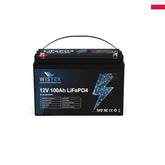What is the Minimum Voltage for a Golf Cart Battery A Comprehensive Guide
When it comes to powering your golf cart reliably and safely, understanding the lowest safe voltage for golf cart batteries is essential. Whether you're a golf enthusiast, a fleet manager, or someone using a golf cart for personal transportation, recognizing voltage thresholds can help extend battery life, avoid damage, and ensure consistent performance. This guide will break down the technical and practical aspects of voltage in golf cart batteries and provide actionable advice to help you maintain them efficiently.
- Why Voltage Matters in Golf Cart Batteries
- Common Types of Golf Cart Batteries and Their Voltage Ranges
- What Happens When Golf Cart Batteries Drop Below Minimum Voltage
- Monitoring Voltage in Golf Cart Batteries
- Preventing Low Voltage in Golf Cart Batteries
- Best Practices for Maintaining Healthy Voltage in Golf Cart Batteries
- Using a Voltage Chart for Golf Cart Batteries
- Recharging After Dropping Below Minimum Voltage
- How Temperature Affects Voltage in Golf Cart Batteries
- Battery Replacement Considerations Based on Voltage Behavior
- How to Test the Lowest Safe Voltage Under Load
- When to Upgrade Your Golf Cart Battery System
- Understanding the Lowest Safe Voltage for Golf Cart Batteries
Why Voltage Matters in Golf Cart Batteries
What Voltage Indicates in a Battery
Voltage is a measure of electrical potential. In the context of golf cart batteries, it helps determine the battery's state of charge (SoC), condition, and capacity to deliver current. If voltage drops too low, the battery may suffer irreversible damage, especially in deep-cycle applications typical for golf carts.
Safe vs. Critical Voltage Thresholds
Fully Charged (Lead-Acid): ~12.7V (per 12V battery)
Fully Charged (Lithium): ~13.6V
Minimum Safe Voltage (Lead-Acid): 10.5V
Minimum Safe Voltage (Lithium): 11.0V
Dropping below these thresholds can significantly reduce the lifespan of golf cart batteries or make them unable to recharge.
Common Types of Golf Cart Batteries and Their Voltage Ranges
6V, 8V, and 12V Battery Systems
Most golf carts use battery packs made of:
Six 6V batteries = 36V system
Six 8V batteries = 48V system
Four 12V batteries = 48V system
Each type has slightly different minimum and maximum voltages.
Lead-Acid vs. Lithium Batteries
|
Battery Type |
Nominal Voltage |
Minimum Safe Voltage |
|
6V Lead-Acid |
6.3V |
~5.25V |
|
8V Lead-Acid |
8.4V |
~7.0V |
|
12V Lead-Acid |
12.7V |
~10.5V |
|
Lithium (12V) |
13.6V |
~11.0V |
In packs, voltages are summed. For example, a 48V pack made of 6x8V batteries has a minimum safe pack voltage of 42V.
>>See also Can I Use 8 Volt Batteries in a 6 Volt Golf Cart
What Happens When Golf Cart Batteries Drop Below Minimum Voltage
Lead-Acid Batteries
Sulfation: A chemical reaction that makes charging more difficult or impossible
Reduced Capacity: Permanent loss of amp-hours
Increased Internal Resistance: Less efficiency during discharge
Lithium Batteries
BMS Shutdown: The Battery Management System (BMS) disables discharge
Cell Imbalance: Irregular voltage across cells affects long-term performance
No Recovery Charging: Extremely low voltage may cause chargers to ignore the battery
Monitoring Voltage in Golf Cart Batteries
Use a Digital Voltmeter
A voltmeter is a basic yet crucial tool. Measure individual batteries and total pack voltage regularly.
Use a Battery Monitoring System (BMS)
Many lithium golf cart batteries include a smart BMS that:
Reports SoC via Bluetooth or app
Logs usage history
Protects against over-discharge
Preventing Low Voltage in Golf Cart Batteries
Routine Charging
Charge your batteries after every use. Letting golf cart batteries sit discharged accelerates aging.
Avoid Deep Discharge
Try not to use more than 50% of the battery's capacity. This extends the useful life, especially for lead-acid types.
Keep an Eye on Load
High power demand from hill climbs or carrying heavy loads can cause temporary voltage sag. Use power efficiently to avoid dipping below safe voltage.
Best Practices for Maintaining Healthy Voltage in Golf Cart Batteries
Regular Maintenance for Lead-Acid
Check and top off distilled water monthly
Clean terminals and prevent corrosion
Equalize charge once per month
Optimization Tips for Lithium Batteries
Store at ~50% SoC if not used for long periods
Avoid extreme temperatures (<0°C or >45°C)
Use matched battery packs to ensure balance
Using a Voltage Chart for Golf Cart Batteries
Having a reference chart makes it easier to evaluate battery health. Here's a general voltage guide for 12V batteries:
|
State of Charge |
Lead-Acid Voltage |
Lithium Voltage |
|
100% |
12.7V |
13.6V |
|
75% |
12.4V |
13.2V |
|
50% |
12.1V |
12.8V |
|
25% |
11.8V |
12.4V |
|
0% |
10.5V |
11.0V |
Multiply these numbers by the number of batteries in your system to assess total pack voltage.
Recharging After Dropping Below Minimum Voltage
For Lead-Acid
Use a multi-stage charger (bulk, absorption, float
If battery won’t charge, try a manual low-current charger
Equalize charge if possible to restore balance
For Lithium
Some chargers won’t recognize deeply discharged batteries
Use a bench power supply to trickle up to recognition threshold
Contact manufacturer if BMS remains shut
How Temperature Affects Voltage in Golf Cart Batteries
Temperature influences internal resistance and chemical reactions:
Cold: Voltage drops faster under load
Heat: Can raise voltage slightly but accelerate degradation
Keep golf cart batteries at moderate temperatures (10°C to 30°C) for optimal performance.
Battery Replacement Considerations Based on Voltage Behavior
If you find that your golf cart batteries drop below minimum voltage frequently, it's time to consider replacement:
Drop below safe voltage under small loads
Do not hold a charge after charging
Voltmeter shows significant imbalance between batteries
>>See also Chinese-Made Power Bank Gains Spotlight After Trump-Musk Interview
How to Test the Lowest Safe Voltage Under Load
To truly know the safe limits of your golf cart batteries, perform a load test:
Use a 100A battery tester
Observe voltage sag during 10-second load
If voltage drops >1.5V, battery may be nearing end of life
When to Upgrade Your Golf Cart Battery System
Consider upgrading to lithium when:
You regularly hit minimum voltage despite proper use
Charging time and maintenance are excessive
Weight and range are important factors
Lithium golf cart batteries can operate closer to minimum voltage without damage and recharge more quickly.
Understanding the Lowest Safe Voltage for Golf Cart Batteries
Whether you're using lead-acid or lithium, knowing the lowest safe voltage for your golf cart batteries can prevent costly damage, extend battery life, and keep your cart running smoothly. With proper monitoring, maintenance, and care, your golf cart batteries will deliver consistent performance and longer lifespans. Use voltmeters, stay above critical thresholds, and act quickly when voltage dips. Understanding the lowest safe voltage for golf cart batteries is your first step toward smart, reliable battery management.



















Leave a comment
All blog comments are checked prior to publishing